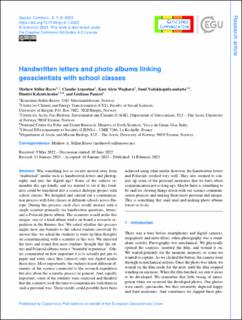| dc.contributor.author | Stiller-Reeve, Mathew Alexander | |
| dc.contributor.author | Argentino, Claudio | |
| dc.contributor.author | Waghorn, Kate Alyse | |
| dc.contributor.author | Vadakkepuliyambatta, Sunil | |
| dc.contributor.author | Kalenitchenko, Dimitri | |
| dc.contributor.author | Panieri, Giuliana | |
| dc.date.accessioned | 2023-03-30T13:05:23Z | |
| dc.date.available | 2023-03-30T13:05:23Z | |
| dc.date.created | 2023-02-14T13:44:32Z | |
| dc.date.issued | 2023 | |
| dc.identifier.issn | 2569-7102 | |
| dc.identifier.uri | https://hdl.handle.net/11250/3061208 | |
| dc.description.abstract | Was something lost as society moved away from “traditional” media such as handwritten letters and photography and into the digital age? Some of the authors remember this age fondly, and we wanted to see if this fondness could be translated into a science dialogue project with school classes. We designed and carried out a communication process with four classes at different schools across Europe. During this process, each class would interact with a single scientist primarily via handwritten questions, letters, and a Polaroid photo album. The scientists would make this unique, one-of-a-kind album whilst on board a research expedition in the Barents Sea. We asked whether this process might show any benefits to the school students involved. To answer this, we asked the students to write up their thoughts on communicating with a scientist in this way. We analysed the texts and found that most students thought that the letters and Polaroid albums were a “beautiful experience”. Others commented on how important it is to actually put pen to paper and write since they (almost) only use digital media these days. Most importantly, the students learnt different elements of the science connected to the research expedition but also about the scientific process in general. And, equally important, some of the students were surprised and thankful that the scientists took the time to communicate with them in such a personal way. These results could possibly have been achieved using other media; however, the handwritten letters and Polaroids worked very well. They also seemed to conjure up some of the personal memories that we have about communication not so long ago. Maybe there is something to be said for slowing things down with our science communication projects and making them more personal and unique. This is something that snail mail and making photo albums forces us to do. | en_US |
| dc.language.iso | eng | en_US |
| dc.publisher | Copernicus Publications | en_US |
| dc.rights | Navngivelse 4.0 Internasjonal | * |
| dc.rights.uri | http://creativecommons.org/licenses/by/4.0/deed.no | * |
| dc.title | Handwritten letters and photo albums linking geoscientists with school classes | en_US |
| dc.type | Journal article | en_US |
| dc.type | Peer reviewed | en_US |
| dc.description.version | publishedVersion | en_US |
| dc.rights.holder | Copyright Author(s) 2023 | en_US |
| cristin.ispublished | true | |
| cristin.fulltext | original | |
| cristin.qualitycode | 1 | |
| dc.identifier.doi | https://doi.org/10.5194/gc-6-1-2023 | |
| dc.identifier.cristin | 2125978 | |
| dc.source.journal | Geoscience Communication | en_US |
| dc.source.pagenumber | 1-9 | en_US |
| dc.relation.project | Norges forskningsråd: 287869 | en_US |
| dc.relation.project | Norges forskningsråd: 223259 | en_US |
| dc.identifier.citation | Geoscience Communication. 2023, 6, 1-9. | en_US |
| dc.source.volume | 6 | en_US |

